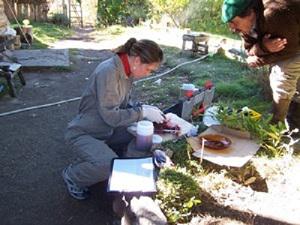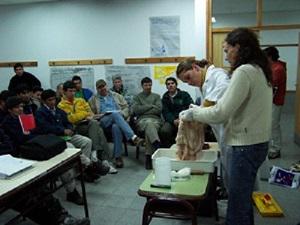Elizabeth Chang Reissig
Other projects
26 Jul 2010
Disease Risks for Native Deer Species, Associated to Exotic Ungulates Cervus elaphus and Sus scrofa in National Parks of Northern Patagonia, Argentina
30 Jan 2015
Disease Risks for Native Deer Species, Associated to Exotic Ungulates in National Parks of Northern Patagonia, Argentina
Assess the risk of diseases transmission from exotic to native species and generate basic information for an efficient management of red deer and wild boar Patagonian populations.

Sampling collection at the field.
The role of exotic mammals in the transmission of diseases to native fauna has not been yet evaluated in Argentina. There is scanty information about the introduction of diseases to native deer, particularly those that are endangered. Nahuel Huapi National Park comprises a protected area of 7.100 km2 of Andes Mountains, template forest, and steppe. The vertebrate diversity includes regional endemism, such as the huemul (Hippocamelus bisulcus) and the pudu (Pudu puda) deers. However, as a result of habitat loss and competition with exotic mammals there are numerous species that are declining in number and are close to extinction, including the huemul. Clearly, in the fragile, unbalanced situation presented above, diseases may accelerate the extinction process.

Hunter guides and park rangers sampling collection training
The potential of infectious diseases being introduced by exotic ungulates is a major concern for native deer conservation programs, since it could endanger the species survival. Exotic ungulates are considered a threat to native wildlife because they compete for food and space resources, and may harbour diseases. It is reasonable to expect that livestock diseases present in exotic ungulate populations may also affect native ungulates. Therefore, clinical screening during hunting seasons are being regularly undertaken to quantify the health risks posed by exotic mammals and to highlight specific problems concerning the wellbeing of native fauna and people. Laboratory analyses are being conducted from hunted-animal samples to detect whether infected individuals are potential disease carriers. Once factors involved in disease diagnostic are determined and evaluated, a health management programme to control and prevent diseases will be developed.
The obtained results will be compared with findings reported in other countries with similar species. For the transference and diffusion of the information obtained in this study a health protocol will be elaborated with procedures for a rational management of animals in hunting sites. Training will also be given to park rangers, hunters, farmers and professionals related to the activity in practical aspects.
General aim: The purpose of the health assessment in exotic mammals is to establish what diseases are present and which could pose a serious risk to the wild native fauna and people at the Nahuel Huapi National Park, and neighbourhood areas.
Specific aims:
Diagnostic and description of diseases in red deer and wild boar.
Assessment of disease-transmission risk from exotic ungulates to native fauna and humans.
Design of health screening protocols in order to prevent the transmission of diseases.